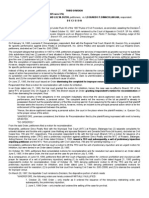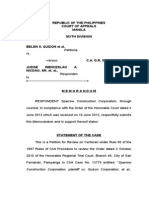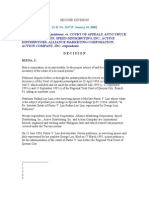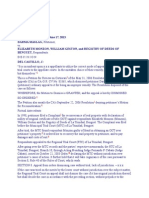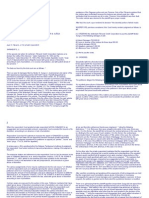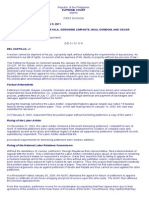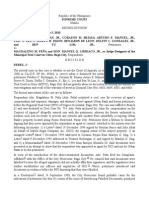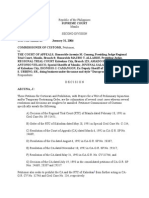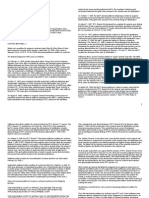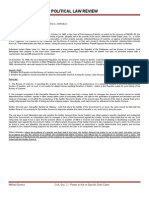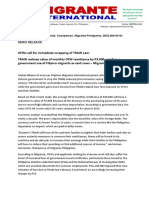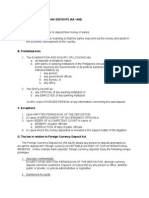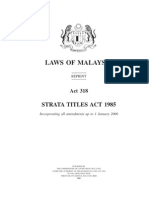Judgment) Awarding The Plaintiff Class A Total of One Billion Nine Hundred Sixty Four Million Five Thousand Eight Hundred
Judgment) Awarding The Plaintiff Class A Total of One Billion Nine Hundred Sixty Four Million Five Thousand Eight Hundred
Uploaded by
Man HernandoCopyright:
Available Formats
Judgment) Awarding The Plaintiff Class A Total of One Billion Nine Hundred Sixty Four Million Five Thousand Eight Hundred
Judgment) Awarding The Plaintiff Class A Total of One Billion Nine Hundred Sixty Four Million Five Thousand Eight Hundred
Uploaded by
Man HernandoOriginal Description:
Original Title
Copyright
Available Formats
Share this document
Did you find this document useful?
Is this content inappropriate?
Copyright:
Available Formats
Judgment) Awarding The Plaintiff Class A Total of One Billion Nine Hundred Sixty Four Million Five Thousand Eight Hundred
Judgment) Awarding The Plaintiff Class A Total of One Billion Nine Hundred Sixty Four Million Five Thousand Eight Hundred
Uploaded by
Man HernandoCopyright:
Available Formats
Republic of the Philippines
SUPREME COURT
Manila
SECOND DIVISION
G.R. No. 139325 April 12, 2005
PRISCILLA C. MIJARES, LORETTA ANN P. ROSALES, HILDA . NARCISO, SR. MARIANI DIMARANAN, S!IC, "#$
JOEL C. LAMANGAN i# %&'ir ('&"l) "#$ o# ('&"l) o) %&' Cl"** Pl"i#%i))* i# Cl"** A+%io# No. MDL ,-0, U#i%'$ S%"%'*
Di*%ri+% Co.r% o) H"/"ii, Petitioner,
vs.
HON. SANTIAGO JA0IER RANADA, i# &i* +"p"+i%1 "* Pr'*i$i#2 J.$2' o) r"#+& 133, R'2io#"l Tri"l Co.r%, M"4"%i
Ci%1, "#$ %&' ESTATE O! !ERDINAND E. MARCOS, %&ro.2& i%* +o.r% "ppoi#%'$ l'2"l r'pr'*'#%"%i5'* i# Cl"** A+%io#
MDL ,-0, U#i%'$ S%"%'* Di*%ri+% Co.r% o) H"/"ii, #"6'l17 I6'l$" R. M"r+o* "#$ !'r$i#"#$ M"r+o*, Jr., Respondents.
D E C I S I O N
TINGA, J.7
Our artial la! e"perience bore stran#e un!anted fruits, and !e have $et to finish !eedin# out its bitter crop. %hile the
restoration of freedo and the fundaental structures and processes of deocrac$ have been uch lauded, accordin# to a
si#nificant nuber, the chan#es, ho!ever, have not sufficientl$ healed the colossal daa#e !rou#ht under the oppressive
conditions of the artial la! period. &he cries of 'ustice for the tortured, the urdered, and the desaparecidos arouse outra#e
and s$path$ in the hearts of the fair(inded, $et the dispensation of the appropriate relief due the cannot be e"tended
throu#h the sae caprice or !hi that characteri)ed the ill(!ind of artial rule. &he daa#e done !as not erel$ personal
but institutional, and the proper rebu*e to the ini+uitous past has to involve the a!ard of reparations due !ithin the confines
of the restored rule of la!.
&he petitioners in this case are proinent victis of huan ri#hts violations1 !ho, deprived of the opportunit$ to directl$
confront the an !ho once held absolute rule over this countr$, have chosen to do battle instead !ith the earthl$
representative, his estate. &he clash has been for no! interrupted b$ a trial court rulin#, seein#l$ coported to le#al lo#ic,
that re+uired the petitioners to pa$ a !hoppin# filin# fee of over ,our -undred Sevent$(&!o Million Pesos .P/01,222,222.223
in order that the$ be able to enforce a 'ud#ent a!arded the b$ a forei#n court. &here is an understandable teptation to
cast the stru##le !ithin the siplistic confines of a oralit$ tale, and to eplo$ short(cuts to arrive at !hat i#ht see the
desirable solution. 4ut eas$, refle"ive resort to the e+uit$ principle all too often leads to a result that a$ be orall$ correct,
but le#all$ !ron#.
Nonetheless, the application of the le#al principles involved in this case !ill cofort those !ho aintain that our substantive
and procedural la!s, for all their perceived abi#uit$ and susceptibilit$ to $riad interpretations, are inherentl$ fair and 'ust.
&he relief sou#ht b$ the petitioners is e"pressl$ andated b$ our la!s and confors to established le#al principles. &he
#rantin# of this petition for certiorari is !arranted in order to correct the le#all$ infir and unabashedl$ un'ust rulin# of the
respondent 'ud#e.
&he essential facts bear little elaboration. On 5 Ma$ 6556, a coplaint !as filed !ith the 7nited States District Court .7S
District Court3, District of -a!aii, a#ainst the Estate of forer Philippine President ,erdinand E. Marcos .Marcos Estate3. &he
action !as brou#ht forth b$ ten ,ilipino citi)ens2 !ho each alle#ed havin# suffered huan ri#hts abuses such as arbitrar$
detention, torture and rape in the hands of police or ilitar$ forces durin# the Marcos re#ie.3 &he 8lien &ort 8ct !as
invo*ed as basis for the 7S District Court9s 'urisdiction over the coplaint, as it involved a suit b$ aliens for tortious violations
of international la!.4 &hese plaintiffs brou#ht the action on their o!n behalf and on behalf of a class of siilarl$ situated
individuals, particularl$ consistin# of all current civilian citi)ens of the Philippines, their heirs and beneficiaries, !ho bet!een
6501 and 65:0 !ere tortured, suaril$ e"ecuted or had disappeared !hile in the custod$ of ilitar$ or parailitar$ #roups.
Plaintiffs alle#ed that the class consisted of appro"iatel$ ten thousand .62,2223 ebers; hence, 'oinder of all these
persons !as ipracticable.
&he institution of a class action suit !as !arranted under Rule 1<.a3 and .b3.63.43 of the 7S ,ederal Rules of Civil
Procedure, the provisions of !hich !ere invo*ed b$ the plaintiffs. Subse+uentl$, the 7S District Court certified the case as a
class action and created three .<3 sub(classes of torture, suar$ e"ecution and disappearance victis.5 &rial ensued, and
subse+uentl$ a 'ur$ rendered a verdict and an a!ard of copensator$ and e"eplar$ daa#es in favor of the plaintiff class.
&hen, on < ,ebruar$ 655=, the 7S District Court, presided b$ >ud#e Manuel ?. Real, rendered a ,inal >ud#ent (Final
Judgment) a!ardin# the plaintiff class a total of One 4illion Nine -undred Si"t$ ,our Million ,ive &housand Ei#ht -undred
,ift$ Nine Dollars and Ninet$ Cents .@6,5A/,22=,:=5.523. &he Final Judgment !as eventuall$ affired b$ the 7S Court of
8ppeals for the Ninth Circuit, in a decision rendered on 60 Deceber 655A.6
On 12 Ma$ 6550, the present petitioners filed Complaint !ith the Re#ional &rial Court, Cit$ of Ma*ati .Ma*ati R&C3 for the
enforceent of the Final Judgment. &he$ alle#ed that the$ are ebers of the plaintiff class in !hose favor the 7S District
Court a!arded daa#es.7 &he$ ar#ued that since the Marcos Estate failed to file a petition for certiorari !ith the 7S
Supree Court after the Ninth Circuit Court of 8ppeals had affired the Final Judgment, the decision of the 7S District Court
had becoe final and e"ecutor$, and hence should be reco#ni)ed and enforced in the Philippines, pursuant to Section =2,
Rule <5 of the Rules of Court then in force.8
On = ,ebruar$ 655:, the Marcos Estate filed a otion to disiss, raisin#, aon# others, the non(pa$ent of the correct filin#
fees. It alle#ed that petitioners had onl$ paid ,our -undred &en Pesos .P/62.223 as doc*et and filin# fees, not!ithstandin#
the fact that the$ sou#ht to enforce a onetar$ aount of daa#es in the aount of over &!o and a Buarter 4illion 7S
Dollars .7S@1.1= 4illion3. &he Marcos Estate cited Supree Court Circular No. 0, pertainin# to the proper coputation and
pa$ent of doc*et fees. In response, the petitioners claied that an action for the enforceent of a forei#n 'ud#ent is not
capable of pecuniar$ estiation; hence, a filin# fee of onl$ ,our -undred &en Pesos .P/62.223 !as proper, pursuant to
Section 0.c3 of Rule 6/6.9
On 5 Septeber 655:, respondent >ud#e Santia#o >avier Ranada10 of the Ma*ati R&C issued the sub'ect Orderdisissin#
the coplaint !ithout pre'udice. Respondent 'ud#e opined that contrar$ to the petitioners9 subission, the sub'ect atter of
the coplaint !as indeed capable of pecuniar$ estiation, as it involved a 'ud#ent rendered b$ a forei#n court orderin# the
pa$ent of definite sus of one$, allo!in# for eas$ deterination of the value of the forei#n 'ud#ent. On that score,
Section 0.a3 of Rule 6/6 of the Rules of Civil Procedure !ould find application, and the R&C estiated the proper aount of
filin# fees !as appro"iatel$ ,our -undred Sevent$ &!o Million Pesos, !hich obviousl$ had not been paid.
Not surprisin#l$, petitioners filed a Motion for Reconsideration, !hich >ud#e Ranada denied in an Order dated 1: >ul$ 6555.
,ro this denial, petitioners filed a Petition for Certiorari under Rule A= assailin# the t!in orders of respondent
'ud#e.11 &he$ pra$ed for the annulent of the +uestioned orders, and an order directin# the reinstateent of Civil Case No.
50(62=1 and the conduct of appropriate proceedin#s thereon.
Petitioners subit that their action is incapable of pecuniar$ estiation as the sub'ect atter of the suit is the enforceent of
a forei#n 'ud#ent, and not an action for the collection of a su of one$ or recover$ of daa#es. &he$ also point out that
to re+uire the class plaintiffs to pa$ ,our -undred Sevent$ &!o Million Pesos .P/01,222,222.223 in filin# fees !ould ne#ate
and render inutile the liberal construction ordained b$ the Rules of Court, as re+uired b$ Section A, Rule 6 of the Rules of
Civil Procedure, particularl$ the ine"pensive disposition of ever$ action.
Petitioners invo*e Section 66, 8rticle III of the 4ill of Ri#hts of the Constitution, !hich provides that C,ree access to the courts
and +uasi('udicial bodies and ade+uate le#al assistance shall not be denied to an$ person b$ reason of povert$,C a andate
!hich is essentiall$ defeated b$ the re+uired e"orbitant filin# fee. &he ad'udicated aount of the filin# fee, as arrived at b$
the R&C, !as characteri)ed as indisputabl$ unfair, ine+uitable, and un'ust.
&he Coission on -uan Ri#hts .C-R3 !as peritted to intervene in this case.12 It ur#ed that the petition be #ranted and
a 'ud#ent rendered, orderin# the enforceent and e"ecution of the District Court 'ud#ent in accordance !ith Section /:,
Rule <5 of the 6550 Rules of Civil Procedure. ,or the C-R, the Ma*ati R&C erred in interpretin# the action for the e"ecution
of a forei#n 'ud#ent as a ne! case, in violation of the principle that once a case has been decided bet!een the sae
parties in one countr$ on the sae issue !ith finalit$, it can no lon#er be reliti#ated a#ain in another countr$. 13 &he C-R
li*e!ise invo*es the principle of coit$, and of vested ri#hts.
&he Court9s disposition on the issue of filin# fees !ill prove a useful 'urisprudential #uidepost for courts confronted !ith
actions enforcin# forei#n 'ud#ents, particularl$ those lod#ed a#ainst an estate. &here is no basis for the issuance a
liited pro hac vice rulin# based on the special circustances of the petitioners as victis of artial la!, or on the
eotionall$(char#ed alle#ation of huan ri#hts abuses.
8n e"aination of Rule 6/6 of the Rules of Court readil$ evinces that the respondent 'ud#e i#nored the clear letter of the la!
!hen he concluded that the filin# fee be coputed based on the total su claied or the stated value of the propert$ in
liti#ation.
In disissin# the coplaint, the respondent 'ud#e relied on Section 0.a3, Rule 6/6 as basis for the coputation of the filin#
fee of over P/01 Million. &he provision statesD
SEC. 0. Cler* of Re#ional &rial Court.(
.a3 ,or filin# an action or a perissive counterclai or 6o#'1 +l"i6 "2"i#*% "# '*%"%' #o% ("*'$ o#
8.$26'#%, or for filin# !ith leave of court a third(part$, fourth(part$, etc., coplaint, or a coplaint in
intervention, and for all clerical services in the sae tie, if the total su claied, e"clusive of interest, or
the started value of the propert$ in liti#ation, isD
6. ?ess than P 622,22.22 E P =22.22
1. P 622,222.22 or ore but less than P 6=2,222.22 E P :22.22
<. P 6=2,222.22 or ore but less than P 122,222.22 E P 6,222.22
/. P 122,222.22 or ore but less than P 1=2,222.22 E P 6,=22.22
=. P 1=2,222.22 or ore but less than P <22,22.22 E P 6,0=2.22
A. P <22,222.22 or ore but not ore than P /22,222.22 E P 1,222.22
0. P <=2,222.22 or ore but not ore than P/22,222.22 E P 1,1=2.22
:. ,or each P 6,222.22 in e"cess of P /22,222.22 E P 62.22
.Ephasis supplied3
Obviousl$, the above(+uoted provision covers, on one hand, ordinar$ actions, perissive counterclais, third(part$, etc.
coplaints and coplaints(in(interventions, and on the other, one$ clais a#ainst estates !hich are not based on
'ud#ent. &hus, the relevant +uestion for purposes of the present petition is !hether the action filed !ith the lo!er court is a
Cone$ clai a#ainst an estate not based on 'ud#ent.C
Petitioners9 coplaint a$ have been lod#ed a#ainst an estate, but it is clearl$ based on a 'ud#ent, the Final Judgment of
the 7S District Court. &he provision does not a*e an$ distinction bet!een a local 'ud#ent and a forei#n 'ud#ent, and
!here the la! does not distin#uish, !e shall not distin#uish.
8 readin# of Section 0 in its entiret$ reveals several instances !herein the filin# fee is coputed on the basis of the aount
of the relief sou#ht, or on the value of the propert$ in liti#ation. &he filin# fee for re+uests for e"tra'udicial foreclosure of
ort#a#e is based on the aount of indebtedness or the ort#a#ee9s clai.14 In special proceedin#s involvin# properties
such as for the allo!ance of !ills, the filin# fee is a#ain based on the value of the propert$.15 &he aforecited rules evidentl$
have no application to petitioners9 coplaint.
Petitioners rel$ on Section 0.b3, particularl$ the proviso on actions !here the value of the sub'ect atter cannot be estiated.
&he provision reads in fullD
SEC. 0. Cler* of Re#ional &rial Court.(
.b3 ,or filin#
6. 8ctions !here the value
of the sub'ect atter
cannot be estiated ((( P A22.22
1. Special civil actions e"cept
'udicial foreclosure !hich
shall be #overned b$
para#raph .a3 above ((( P A22.22
<. 8ll other actions not
involvin# propert$ ((( P A22.22
In a real action, the assessed value of the propert$, or if there is none, the estiated value, thereof shall be alle#ed b$ the
claiant and shall be the basis in coputin# the fees.
It is !orth notin# that the provision also provides that in real actions, the assessed value or estiated value of the propert$
shall be alle#ed b$ the claiant and shall be the basis in coputin# the fees. Fet a#ain, this provision does not appl$ in the
case at bar. 8 real action is one !here the plaintiff see*s the recover$ of real propert$ or an action affectin# title to or
recover$ of possession of real propert$.16 Neither the coplaint nor the a!ard of daa#es ad'udicated b$ the 7S District
Court involves an$ real propert$ of the Marcos Estate.
&hus, respondent 'ud#e !as in clear and serious error !hen he concluded that the filin# fees should be coputed on the
basis of the scheatic table of Section 0.a3, as the action involved pertains to a clai a#ainst an estate based on 'ud#ent.
%hat provision, if an$, then should appl$ in deterinin# the filin# fees for an action to enforce a forei#n 'ud#entG
&o resolve this +uestion, a proper understandin# is re+uired on the nature and effects of a forei#n 'ud#ent in this
'urisdiction.
&he rules of coit$, utilit$ and convenience of nations have established a usa#e aon# civili)ed states b$ !hich final
'ud#ents of forei#n courts of copetent 'urisdiction are reciprocall$ respected and rendered efficacious under certain
conditions that a$ var$ in different countries.17 &his principle !as proinentl$ affired in the leadin# 8erican case
of Hilton v. Guot18 and e"pressl$ reco#ni)ed in our 'urisprudence be#innin# !ith !ngenholl v. "alter #. Olsen $ Co.19 &he
conditions re+uired b$ the Philippines for reco#nition and enforceent of a forei#n 'ud#ent !ere ori#inall$ contained in
Section <66 of the Code of Civil Procedure, !hich !as ta*en fro the California Code of Civil Procedure !hich, in turn, !as
derived fro the California 8ct of March 66, 6:01.20Rear*abl$, the procedural rule no! outlined in Section /:, Rule <5 of
the Rules of Civil Procedure has reained unchan#ed do!n to the last !ord in nearl$ a centur$. Section /: statesD
SEC. /:. Effect of forei#n 'ud#ents. H &he effect of a 'ud#ent of a tribunal of a forei#n countr$, havin#
'urisdiction to pronounce the 'ud#ent is as follo!sD
.a3 In case of a 'ud#ent upon a specific thin#, the 'ud#ent is conclusive upon the title to the thin#;
.b3 In case of a 'ud#ent a#ainst a person, the 'ud#ent is presuptive evidence of a ri#ht as bet!een the
parties and their successors in interest b$ a subse+uent title;
In either case, the 'ud#ent or final order a$ be repelled b$ evidence of a !ant of 'urisdiction, !ant of notice to the
part$, collusion, fraud, or clear ista*e of la! or fact.
&here is an evident distinction bet!een a forei#n 'ud#ent in an action in rem and one in personam. ,or an actionin rem% the
forei#n 'ud#ent is deeed conclusive upon the title to the thin#, !hile in an action in personam% the forei#n 'ud#ent is
presuptive, and not conclusive, of a ri#ht as bet!een the parties and their successors in interest b$ a subse+uent
title.21 -o!ever, in both cases, the forei#n 'ud#ent is susceptible to ipeachent in our local courts on the #rounds of
!ant of 'urisdiction or notice to the part$,22 collusion, fraud,23 or clear ista*e of la! or fact.24 &hus, the part$ a##rieved
b$ the forei#n 'ud#ent is entitled to defend a#ainst the enforceent of such decision in the local foru. It is essential that
there should be an opportunit$ to challen#e the forei#n 'ud#ent, in order for the court in this 'urisdiction to properl$
deterine its efficac$.25
It is clear then that it is usuall$ necessar$ for an action to be filed in order to enforce a forei#n 'ud#ent 26, even if such
'ud#ent has conclusive effect as in the case of in rem actions, if onl$ for the purpose of allo!in# the losin# part$ an
opportunit$ to challen#e the forei#n 'ud#ent, and in order for the court to properl$ deterine its efficac$.27 Conse+uentl$,
the part$ attac*in# a forei#n 'ud#ent has the burden of overcoin# the presuption of its validit$.28
&he rules are silent as to !hat initiator$ procedure ust be underta*en in order to enforce a forei#n 'ud#ent in the
Philippines. 4ut there is no +uestion that the filin# of a civil coplaint is an appropriate easure for such purpose. 8 civil
action is one b$ !hich a part$ sues another for the enforceent or protection of a ri#ht,29 and clearl$ an action to enforce a
forei#n 'ud#ent is in essence a vindication of a ri#ht prescindin# either fro a Cconclusive 'ud#ent upon titleC or the
Cpresuptive evidence of a ri#ht.C30 8bsent perhaps a statutor$ #rant of 'urisdiction to a +uasi('udicial bod$, the clai for
enforceent of 'ud#ent ust be brou#ht before the re#ular courts.31
&here are distinctions, nuanced but discernible, bet!een the cause of action arisin# fro the enforceent of a forei#n
'ud#ent, and that arisin# fro the facts or alle#ations that occasioned the forei#n 'ud#ent. &he$ a$ pertain to the sae
set of facts, but there is an essential difference in the ri#ht(dut$ correlatives that are sou#ht to be vindicated. ,or e"aple, in
a coplaint for daa#es a#ainst a tortfeasor, the cause of action eanates fro the violation of the ri#ht of the coplainant
throu#h the act or oission of the respondent. On the other hand, in a coplaint for the enforceent of a forei#n 'ud#ent
a!ardin# daa#es fro the sae tortfeasor, for the violation of the sae ri#ht throu#h the sae anner of action, the cause
of action derives not fro the tortious act but fro the forei#n 'ud#ent itself.
More iportantl$, the atters for proof are different. 7sin# the above e"aple, the coplainant !ill have to establish before
the court the tortious act or oission coitted b$ the tortfeasor, !ho in turn is allo!ed to rebut these factual alle#ations or
prove e"tenuatin# circustances. E"tensive liti#ation is thus conducted on the facts, and fro there the ri#ht to and aount
of daa#es are assessed. On the other hand, in an action to enforce a forei#n 'ud#ent, the atter left for proof is the
forei#n 'ud#ent itself, and not the facts fro !hich it prescinds.
8s stated in Section /:, Rule <5, the actionable issues are #enerall$ restricted to a revie! of 'urisdiction of the forei#n court,
the service of personal notice, collusion, fraud, or ista*e of fact or la!. &he liitations on revie! is in consonance !ith a
stron# and pervasive polic$ in all le#al s$stes to liit repetitive liti#ation on clais and issues.32 Other!ise *no!n as the
polic$ of preclusion, it see*s to protect part$ e"pectations resultin# fro previous liti#ation, to safe#uard a#ainst the
harassent of defendants, to insure that the tas* of courts not be increased b$ never(endin# liti#ation of the sae disputes,
and E in a lar#er sense E to proote !hat ?ord Co*e in the Ferrer&s Case of 6=55 stated to be the #oal of all la!D Crest and
+uietness.C33 If ever$ 'ud#ent of a forei#n court !ere revie!able on the erits, the plaintiff !ould be forced bac* on hisIher
ori#inal cause of action, renderin# iaterial the previousl$ concluded liti#ation.34
Petitioners appreciate this distinction, and rel$ upon it to support the proposition that the sub'ect atter of the coplaintJthe
enforceent of a forei#n 'ud#entJis incapable of pecuniar$ estiation. 8dittedl$ the proposition, as it applies in this case,
is counter(intuitive, and thus deserves strict scrutin$. ,or in all practical intents and purposes, the atter at hand is capable of
pecuniar$ estiation, do!n to the last cent. In the assailedOrder% the respondent 'ud#e pounced upon this point !ithout
e+uivocationD
&he Rules use the ter C!here the value of the sub'ect atter cannot be estiated.C &he sub'ect atter of the
present case is the 'ud#ent rendered b$ the forei#n court orderin# defendant to pa$ plaintiffs definite sus of
one$, as and for copensator$ daa#es. &he Court finds that the value of the forei#n 'ud#ent can be estiated;
indeed, it can even be easil$ deterined. &he Court is not inded to distin#uish bet!een the enforceent of a
'ud#ent and the aount of said 'ud#ent, and separate the t!o, for purposes of deterinin# the correct filin# fees.
Siilarl$, a plaintiff suin# on proissor$ note for P6 illion cannot be allo!ed to pa$ onl$ P/22 filin# fees (sic), on
the reasonin# that the sub'ect atter of his suit is not the P6 illion, but the enforceent of the proissor$ note,
and that the value of such CenforceentC cannot be estiated.35
&he 'urisprudential standard in #au#in# !hether the sub'ect atter of an action is capable of pecuniar$ estiation is !ell(
entrenched. &he Marcos Estate cites 'ingsong v. !sa(ela 'a)mill and Ramundo v. Court of *ppeals, !hich ruledD
KILn deterinin# !hether an action is one the sub'ect atter of !hich is not capable of pecuniar$ estiation this
Court has adopted the criterion of first ascertainin# the nature of the principal action or reed$ sou#ht. If it is
priaril$ for the recover$ of a su of one$, the clai is considered capable of pecuniar$ estiation, and !hether
'urisdiction is in the unicipal courts or in the courts of first instance !ould depend on the aount of the clai.
-o!ever, !here the basic issue is soethin# other than the ri#ht to recover a su of one$, !here the one$
clai is purel$ incidental to, or a conse+uence of, the principal relief sou#ht, this Court has considered such actions
as cases !here the sub'ect of the liti#ation a$ not be estiated in ters of one$, and are co#ni)able e"clusivel$
b$ courts of first instance .no! Re#ional &rial Courts3.
On the other hand, petitioners cite the ponencia of >ustice >4? Re$es in +apitan v. 'candia,36 fro !hich the rule
in 'ingsong and Ramundo actuall$ derives, but !hich incorporates this additional nuance oitted in the latter casesD
""" -o!ever, !here the basic issue is soethin# other than the ri#ht to recover a su of one$, !here the one$
clai is purel$ incidental to, or a conse+uence of, the principal relief sou#ht, li4' i# *.i%* %o &"5' %&' $')'#$"#%
p'r)or6 &i* p"r% o) %&' +o#%r"+% 9*p'+i)i+ p'r)or6"#+': "#$ i# "+%io#* )or *.ppor%, or )or "##.l6'#% o)
8.$26'#% or %o )or'+lo*' " 6or%2"2', this Court has considered such actions as cases !here the sub'ect of the
liti#ation a$ not be estiated in ters of one$, and are co#ni)able e"clusivel$ b$ courts of first instance.37
Petitioners #o on to add that aon# the actions the Court has reco#ni)ed as bein# incapable of pecuniar$ estiation include
le#alit$ of conve$ances and one$ deposits,38 validit$ of a ort#a#e,39 the ri#ht to support,40validit$ of
docuents,41 rescission of contracts,42 specific perforance,43 and validit$ or annulent of 'ud#ents.44 It is ur#ed that
an action for enforceent of a forei#n 'ud#ent belon#s to the sae class.
&his is an intri#uin# ar#uent, but ultiatel$ it is self(evident that !hile the sub'ect atter of the action is undoubtedl$ the
enforceent of a forei#n 'ud#ent, the effect of a providential a!ard !ould be the ad'udication of a su of one$. Perhaps
in theor$, such an action is priaril$ for Cthe enforceent of the forei#n 'ud#ent,C but there is a certain obtuseness to that
sort of ar#uent since there is no den$in# that the enforceent of the forei#n 'ud#ent !ill necessaril$ result in the a!ard of
a definite su of one$.
4ut before !e insist upon this conclusion past be$ond the point of rec*onin#, !e ust e"aine its possible raifications.
Petitioners raise the point that a declaration that an action for enforceent of forei#n 'ud#ent a$ be capable of pecuniar$
estiation i#ht lead to an instance !herein a first level court such as the Municipal &rial Court !ould have 'urisdiction to
enforce a forei#n 'ud#ent. 4ut under the statute definin# the 'urisdiction of first level courts, 4.P. 615, such courts are not
vested !ith 'urisdiction over actions for the enforceent of forei#n 'ud#ents.
Sec. <<. Jurisdiction of Metropolitan ,rial Courts% Municipal ,rial Courts and Municipal Circuit ,rial Courts in civil
cases. H Metropolitan &rial Courts, Municipal &rial Courts, and Municipal Circuit &rial Courts shall e"erciseD
.63 E"clusive ori#inal 'urisdiction over civil actions and probate proceedin#s, testate and intestate, includin# the
#rant of provisional reedies in proper cases, !here the value of the personal propert$, estate, or aount of the
deand does not e"ceed One hundred thousand pesos .P622,222.223 or, in Metro Manila !here such personal
propert$, estate, or aount of the deand does not e"ceed &!o hundred thousand pesos .P122,222.223 e"clusive
of interest daa#es of !hatever *ind, attorne$9s fees, liti#ation e"penses, and costs, the aount of !hich ust be
specificall$ alle#edD Provided, &hat !here there are several clais or causes of action bet!een the sae or
different parties, ebodied in the sae coplaint, the aount of the deand shall be the totalit$ of the clais in all
the causes of action, irrespective of !hether the causes of action arose out of the sae or different transactions;
.13 E"clusive ori#inal 'urisdiction over cases of forcible entr$ and unla!ful detainerD Provided, &hat !hen, in such
cases, the defendant raises the +uestion of o!nership in his pleadin#s and the +uestion of possession cannot be
resolved !ithout decidin# the issue of o!nership, the issue of o!nership shall be resolved onl$ to deterine the
issue of possession.
.<3 E"clusive ori#inal 'urisdiction in all civil actions !hich involve title to, or possession of, real propert$, or an$
interest therein !here the assessed value of the propert$ or interest therein does not e"ceed &!ent$ thousand
pesos .P12,222.223 or, in civil actions in Metro Manila, !here such assessed value does not e"ceed ,ift$ thousand
pesos .P=2,222.223 e"clusive of interest, daa#es of !hatever *ind, attorne$9s fees, liti#ation e"penses and
costsD Provided, &hat value of such propert$ shall be deterined b$ the assessed value of the ad'acent lots.45
Section << of 4.P. 615 refers to instances !herein the cause of action or sub'ect atter pertains to an assertion of ri#hts and
interests over propert$ or a su of one$. 4ut as earlier pointed out, the sub'ect atter of an action to enforce a forei#n
'ud#ent is the forei#n 'ud#ent itself, and the cause of action arisin# fro the ad'udication of such 'ud#ent.
8n e"aination of Section 65.A3, 4.P. 615 reveals that the instant coplaint for enforceent of a forei#n 'ud#ent, even if
capable of pecuniar$ estiation, !ould fall under the 'urisdiction of the Re#ional &rial Courts, thus ne#atin# the fears of the
petitioners. Indeed, an e"aination of the provision indicates that it can be relied upon as 'urisdictional basis !ith respect to
actions for enforceent of forei#n 'ud#ents, provided that no other court or office is vested 'urisdiction over such coplaintD
Sec. 65. Jurisdiction in civil cases. H Re#ional &rial Courts shall e"ercise e"clusive ori#inal 'urisdictionD
"""
.A3 In all cases not !ithin the e"clusive 'urisdiction of an$ court, tribunal, person or bod$ e"ercisin# 'urisdiction or
an$ court, tribunal, person or bod$ e"ercisin# 'udicial or +uasi('udicial functions.
&hus, !e are cofortable in assertin# the obvious, that the coplaint to enforce the 7S District Court 'ud#ent is one
capable of pecuniar$ estiation. 4ut at the sae tie, it is also an action based on 'ud#ent a#ainst an estate, thus placin#
it be$ond the abit of Section 0.a3 of Rule 6/6. %hat provision then #overns the proper coputation of the filin# fees over
the instant coplaintG ,or this case and other siilarl$ situated instances, !e find that it is covered b$ Section 0.b3.<3,
involvin# as it does, Cother actions not involvin# propert$.C
Notabl$, the aount paid as doc*et fees b$ the petitioners on the preise that it !as an action incapable of pecuniar$
estiation corresponds to the sae aount re+uired for Cother actions not involvin# propert$.C &he petitioners thus paid the
correct aount of filin# fees, and it !as a #rave abuse of discretion for respondent 'ud#e to have applied instead a clearl$
inapplicable rule and disissed the coplaint.
&here is another consideration of supree relevance in this case, one !hich should disabuse the notion that the doctrine
affired in this decision is #rounded solel$ on the letter of the procedural rule. %e earlier adverted to the the internationall$
reco#ni)ed polic$ of preclusion,46 as !ell as the principles of coit$, utilit$ and convenience of nations47 as the basis for
the evolution of the rule callin# for the reco#nition and enforceent of forei#n 'ud#ents. &he 7S Supree Court in Hilton v.
Guot48 relied heavil$ on the concept of coit$, as especiall$ derived fro the landar* treatise of >ustice Stor$ in his
Coentaries on the Conflict of ?a!s of 6:</.49 Fet the notion of Ccoit$C has since been critici)ed as one Cof di
contoursC50 or sufferin# fro a nuber of fallacies.51Other conceptual bases for the reco#nition of forei#n 'ud#ents have
evolved such as the vested ri#hts theor$ or the odern doctrine of obli#ation.52
&here have been attepts to codif$ throu#h treaties or ultilateral a#reeents the standards for the reco#nition and
enforceent of forei#n 'ud#ents, but these have not borne fruition. &he ebers of the European Coon Mar*et accede
to the Judgments Convention% si#ned in 650:, !hich eliinates as to participatin# countries all of such obstacles to
reco#nition such as reciprocit$ and r-vision au fond.53 &he ost abitious of these attepts is the Convention on the
Recognition and #nforcement of Foreign Judgments in Civil and Commercial Matters, prepared in 65AA b$ the -a#ue
Conference of International ?a!.54 %hile it has not received the ratifications needed to have it ta*e effect,55 it is reco#ni)ed
as representin# current scholarl$ thou#ht on the topic.56 Neither the Philippines nor the 7nited States are si#natories to the
Convention.
Fet even if there is no unaniit$ as to the applicable theor$ behind the reco#nition and enforceent of forei#n 'ud#ents or a
universal treat$ renderin# it obli#ator$ force, there is consensus that the viabilit$ of such reco#nition and enforceent is
essential. Steiner and Va#ts noteD
. . . &he notion of unconnected bodies of national la! on private international la!, each follo!in# a +uite separate
path, is not one conducive to the #ro!th of a transnational counit$ encoura#in# travel and coerce aon# its
ebers. &here is a conteporar$ resur#ence of !ritin# stressin# the identit$ or siilarit$ of the values that
s$stes of public and private international la! see* to further E a counit$ interest in coon, or at least
reasonable, rules on these atters in national le#al s$stes. 8nd such #eneric principles as reciprocit$ pla$ an
iportant role in both fields.57
Salon#a, !hose treatise on private international la! is of !orld!ide reno!n, points outD
%hatever be the theor$ as to the basis for reco#ni)in# forei#n 'ud#ents, there can be little dispute that the end is
to protect the reasonable e"pectations and deands of the parties. %here the parties have subitted a atter for
ad'udication in the court of one state, and proceedin#s there are not tainted !ith irre#ularit$, the$ a$ fairl$ be
e"pected to subit, !ithin the state or else!here, to the enforceent of the 'ud#ent issued b$ the court.58
&here is also consensus as to the re+uisites for reco#nition of a forei#n 'ud#ent and the defenses a#ainst the enforceent
thereof. 8s earlier discussed, the e"ceptions enuerated in Section /:, Rule <5 have reain unchan#ed since the tie the$
!ere adapted in this 'urisdiction fro lon# standin# 8erican rules. &he re+uisites and e"ceptions as delineated under
Section /: are but a restateent of #enerall$ accepted principles of international la!. Section 5: of &he Restateent,
Second, Conflict of ?a!s, states that Ca valid 'ud#ent rendered in a forei#n nation after a fair trial in a contested proceedin#
!ill be reco#ni)ed in the 7nited States,C and on its face, the ter CvalidC brin#s into pla$ re+uireents such notions as valid
'urisdiction over the sub'ect atter and parties.59 Siilarl$, the notion that fraud or collusion a$ preclude the enforceent
of a forei#n 'ud#ent finds affiration !ith forei#n 'urisprudence and coentators,60 as !ell as the doctrine that the
forei#n 'ud#ent ust not constitute Ca clear ista*e of la! or fact.C61 8nd finall$, it has been reco#ni)ed that Cpublic polic$C
as a defense to the reco#nition of 'ud#ents serves as an ubrella for a variet$ of concerns in international practice !hich
a$ lead to a denial of reco#nition.62
&he viabilit$ of the public polic$ defense a#ainst the enforceent of a forei#n 'ud#ent has been reco#ni)ed in this
'urisdiction.63 &his defense allo!s for the application of local standards in revie!in# the forei#n 'ud#ent, especiall$ !hen
such 'ud#ent creates onl$ a presuptive ri#ht, as it does in cases !herein the 'ud#ent is a#ainst a person.64 &he
defense is also reco#ni)ed !ithin the international sphere, as an$ civil la! nations adhere to a broad public polic$
e"ception !hich a$ result in a denial of reco#nition !hen the forei#n court, in the li#ht of the choice(of(la! rules of the
reco#ni)in# court, applied the !ron# la! to the case.65 &he public polic$ defense can safe#uard a#ainst possible abuses to
the eas$ resort to offshore liti#ation if it can be deonstrated that the ori#inal clai is no"ious to our constitutional values.
&here is no obli#ator$ rule derived fro treaties or conventions that re+uires the Philippines to reco#ni)e forei#n 'ud#ents,
or allo! a procedure for the enforceent thereof. -o!ever, #enerall$ accepted principles of international la!, b$ virtue of the
incorporation clause of the Constitution, for part of the la!s of the land even if the$ do not derive fro treat$
obli#ations.66 &he classical forulation in international la! sees those custoar$ rules accepted as bindin# result fro the
cobination t!o eleentsD the established, !idespread, and consistent practice on the part of States; and a ps$cholo#ical
eleent *no!n as the opinion .uris sive necessitates .opinion as to la! or necessit$3. Iplicit in the latter eleent is a belief
that the practice in +uestion is rendered obli#ator$ b$ the e"istence of a rule of la! re+uirin# it.67
%hile the definite conceptual paraeters of the reco#nition and enforceent of forei#n 'ud#ents have not been
authoritativel$ established, the Court can assert !ith certaint$ that such an underta*in# is aon# those #enerall$ accepted
principles of international la!.68 8s earlier deonstrated, there is a !idespread practice aon# states acceptin# in principle
the need for such reco#nition and enforceent, albeit sub'ect to liitations of var$in# de#rees. &he fact that there is no
bindin# universal treat$ #overnin# the practice is not indicative of a !idespread re'ection of the principle, but onl$ a
disa#reeent as to the iposable specific rules #overnin# the procedure for reco#nition and enforceent.
8side fro the !idespread practice, it is indubitable that the procedure for reco#nition and enforceent is ebodied in the
rules of la!, !hether statutor$ or 'urisprudential, adopted in various forei#n 'urisdictions. In the Philippines, this is evidenced
priaril$ b$ Section /:, Rule <5 of the Rules of Court !hich has e"isted in its current for since the earl$ 6522s. Certainl$,
the Philippine le#al s$ste has lon# a#o accepted into its 'urisprudence and procedural rules the viabilit$ of an action for
enforceent of forei#n 'ud#ent, as !ell as the re+uisites for such valid enforceent, as derived fro internationall$
accepted doctrines. 8#ain, there a$ be distinctions as to the rules adopted b$ each particular state,69 but the$ all prescind
fro the preise that there is a rule of la! obli#in# states to allo! for, ho!ever #enerall$, the reco#nition and enforceent of
a forei#n 'ud#ent. &he bare principle, to our ind, has attained the status of opinio .uris in international practice.
&his is a si#nificant proposition, as it ac*no!led#es that the procedure and re+uisites outlined in Section /:, Rule <5 derive
their efficac$ not erel$ fro the procedural rule, but b$ virtue of the incorporation clause of the Constitution. Rules of
procedure are proul#ated b$ the Supree Court,70 and could ver$ !ell be abro#ated or revised b$ the hi#h court itself. Fet
the Supree Court is obli#ed, as are all State coponents, to obe$ the la!s of the land, includin# #enerall$ accepted
principles of international la! !hich for part thereof, such as those ensurin# the +ualified reco#nition and enforceent of
forei#n 'ud#ents.71
&hus, relative to the enforceent of forei#n 'ud#ents in the Philippines, it eer#es that there is a #eneral ri#ht reco#ni)ed
!ithin our bod$ of la!s, and affired b$ the Constitution, to see* reco#nition and enforceent of forei#n 'ud#ents, as !ell
as a ri#ht to defend a#ainst such enforceent on the #rounds of !ant of 'urisdiction, !ant of notice to the part$, collusion,
fraud, or clear ista*e of la! or fact.
&he preclusion of an action for enforceent of a forei#n 'ud#ent in this countr$ erel$ due to an e"horbitant assessent of
doc*et fees is alien to #enerall$ accepted practices and principles in international la!. Indeed, there are #rave concerns in
conditionin# the aount of the filin# fee on the pecuniar$ a!ard or the value of the propert$ sub'ect of the forei#n decision.
Such pecuniar$ a!ard !ill alost certainl$ be in forei#n denoination, coputed in accordance !ith the applicable la!s and
standards of the foru.72 &he va#aries of inflation, as !ell as the relative lo!(incoe capacit$ of the ,ilipino, to date a$
ver$ !ell translate into an a!ard virtuall$ unenforceable in this countr$, despite its inte#ral validit$, if the doc*et fees for the
enforceent thereof !ere predicated on the aount of the a!ard sou#ht to be enforced. &he theor$ adopted b$ respondent
'ud#e and the Marcos Estate a$ even lead to absurdities, such as if applied to an a!ard involvin# real propert$ situated in
places such as the 7nited States or Scandinavia !here real propert$ values are ine"orabl$ hi#h. %e cannot ver$ !ell re+uire
that the filin# fee be coputed based on the value of the forei#n propert$ as deterined b$ the standards of the countr$
!here it is located.
8s crafted, Rule 6/6 of the Rules of Civil Procedure avoids unreasonableness, as it reco#ni)es that the sub'ect atter of an
action for enforceent of a forei#n 'ud#ent is the forei#n 'ud#ent itself, and not the ri#ht(dut$ correlatives that resulted in
the forei#n 'ud#ent. In this particular circustance, #iven that the coplaint is lod#ed a#ainst an estate and is based on
the 7S District Court9s Final Judgment, this forei#n 'ud#ent a$, for purposes of classification under the #overnin#
procedural rule, be deeed as subsued under Section 0.b3.<3 of Rule 6/6, i.e., !ithin the class of Call other actions not
involvin# propert$.C &hus, onl$ the blan*et filin# fee of inial aount is re+uired.
,inall$, petitioners also invo*e Section 66, 8rticle III of the Constitution, !hich states that CK,Lree access to the courts and
+uasi('udicial bodies and ade+uate le#al assistance shall not be denied to an$ person b$ reason of povert$.C Since the
provision is aon# the #uarantees ensured b$ the 4ill of Ri#hts, it certainl$ #ives rise to a deandable ri#ht. -o!ever, no! is
not the occasion to elaborate on the paraeters of this constitutional ri#ht. Miven our precedin# discussion, it is not
necessar$ to utili)e this provision in order to #rant the relief sou#ht b$ the petitioners. It is a"ioatic that the constitutionalit$
of an act !ill not be resolved b$ the courts if the controvers$ can be settled on other #rounds73 or unless the resolution
thereof is indispensable for the deterination of the case.74
One ore !ord. It bears notin# that Section /:, Rule <5 ac*no!led#es that the Final Judgment is not conclusive $et, but
presuptive evidence of a ri#ht of the petitioners a#ainst the Marcos Estate. Moreover, the Marcos Estate is not precluded to
present evidence, if an$, of !ant of 'urisdiction, !ant of notice to the part$, collusion, fraud, or clear ista*e of la! or fact.
&his rulin#, decisive as it is on the +uestion of filin# fees and no other, does not render verdict on the enforceabilit$ of
the Final Judgment before the courts under the 'urisdiction of the Philippines, or for that atter an$ other issue !hich a$
le#itiatel$ be presented before the trial court. Such issues are to be liti#ated before the trial court, but !ithin the confines of
the atters for proof as laid do!n in Section /:, Rule <5. On the other hand, the speed$ resolution of this clai b$ the trial
court is encoura#ed, and contuacious dela$ of the decision on the erits !ill not be broo*ed b$ this Court.
;HERE!ORE, the petition is MR8N&ED. &he assailed orders are N7??I,IED and SE& 8SIDE, and a ne! order
REINS&8&INM Civil Case No. 50(62=1 is hereb$ issued. No costs.
SO ORDERED.
Puno% (Chairman)% *ustria/Martine0% Calle.o% 'r.% and Chico/1a0ario% JJ.% concur.
You might also like
- ESKIMO PIE Case StudyDocument13 pagesESKIMO PIE Case StudyPablo Vera100% (1)
- Sample Motion to Vacate, Motion to Dismiss, Affidavits, Notice of Objection, and Notice of Intent to File ClaimFrom EverandSample Motion to Vacate, Motion to Dismiss, Affidavits, Notice of Objection, and Notice of Intent to File ClaimRating: 5 out of 5 stars5/5 (23)
- Civil Procedure, San BedaDocument63 pagesCivil Procedure, San Bedaey100% (4)
- Simple Guide for Drafting of Civil Suits in IndiaFrom EverandSimple Guide for Drafting of Civil Suits in IndiaRating: 4.5 out of 5 stars4.5/5 (4)
- Netw Rks Guided Reading Activity: Lesson 5 Governance and New IdeasDocument2 pagesNetw Rks Guided Reading Activity: Lesson 5 Governance and New IdeasJoshua White100% (1)
- Regional Trial Court (RTC) of Quezon City, Branch 101, and Leonardo P. Dimaculangan"Document64 pagesRegional Trial Court (RTC) of Quezon City, Branch 101, and Leonardo P. Dimaculangan"Nikki Rosana RatonNo ratings yet
- Makaslang vs. ZamoraDocument14 pagesMakaslang vs. ZamoraClint M. MaratasNo ratings yet
- Presidential Anti-Dollar Salting Task Force vs. Court of AppealsDocument12 pagesPresidential Anti-Dollar Salting Task Force vs. Court of Appealsvanessa_3No ratings yet
- YFreLegForms - MemorandumDocument15 pagesYFreLegForms - MemorandumEarl Samson NavarroNo ratings yet
- RufinaDocument14 pagesRufinaxynnnnNo ratings yet
- And Milagros H. Reyes v. Remedios Barreno, Lilibeth Ametin, Dranrev F. Nonay, Frederick D. Dionisio and Marites CasioDocument7 pagesAnd Milagros H. Reyes v. Remedios Barreno, Lilibeth Ametin, Dranrev F. Nonay, Frederick D. Dionisio and Marites CasioVictoria AlexanderNo ratings yet
- Ayllon V SevillaDocument2 pagesAyllon V SevillaRAINBOW AVALANCHENo ratings yet
- 01 Holy See v. Rosario (1994)Document5 pages01 Holy See v. Rosario (1994)Zan BillonesNo ratings yet
- Monater Et Al Vs Sharia District Court Et Al, GR No 174975, 01-20-2009Document10 pagesMonater Et Al Vs Sharia District Court Et Al, GR No 174975, 01-20-2009Angeline Samonte-AlcayagaNo ratings yet
- 3 Saavedra V DojDocument5 pages3 Saavedra V DojThomas EdisonNo ratings yet
- Almeda V VillaluzDocument3 pagesAlmeda V VillaluzjerushabrainerdNo ratings yet
- Ursal vs. Court of Tax AppealsDocument2 pagesUrsal vs. Court of Tax Appealsvanessa_3No ratings yet
- Civil Cases Under MTCDocument22 pagesCivil Cases Under MTCShailah Leilene Arce BrionesNo ratings yet
- Supreme Court: Labaguis, Loyola, Angara Law Offices For Petitioner. Juan C. Navarro, Jr. For Private RespondentDocument51 pagesSupreme Court: Labaguis, Loyola, Angara Law Offices For Petitioner. Juan C. Navarro, Jr. For Private RespondentKim AlyssaNo ratings yet
- Republic of The PhilippinesDocument3 pagesRepublic of The PhilippinesJus EneroNo ratings yet
- Borlongan Vs PenaDocument13 pagesBorlongan Vs PenaAnonymous hbUJnBNo ratings yet
- 2 Civ AcDocument5 pages2 Civ AcJenMarkNo ratings yet
- Republic of The PhilippinesDocument32 pagesRepublic of The PhilippinesNoreena Twinkle FajardoNo ratings yet
- Domingo VS. CADocument10 pagesDomingo VS. CALexter CruzNo ratings yet
- HURL Cases 1Document27 pagesHURL Cases 1Zan BillonesNo ratings yet
- Edralin v. Philippine Veterans Bank, GR 168523Document12 pagesEdralin v. Philippine Veterans Bank, GR 168523vylletteNo ratings yet
- Chee Kiong Yam vs. MalikDocument3 pagesChee Kiong Yam vs. MalikDenise Jane DuenasNo ratings yet
- Taytay Vs PujalteDocument10 pagesTaytay Vs PujalteAriel AbisNo ratings yet
- Suit Cannot Be Rejected by Trial Courts For Non-Payment of Court Fee AloneDocument22 pagesSuit Cannot Be Rejected by Trial Courts For Non-Payment of Court Fee AloneLive Law100% (2)
- Case Dismissals For Lack of Standing To ForecloseDocument28 pagesCase Dismissals For Lack of Standing To Foreclosejacque zidane100% (2)
- Cases 1 SalesDocument52 pagesCases 1 SalesbyankahhNo ratings yet
- Rem 2Document63 pagesRem 2Marge RoseteNo ratings yet
- Sps Santos vs. PizardoDocument6 pagesSps Santos vs. PizardonikkaremullaNo ratings yet
- DP Lub Oil Vs NicolasDocument2 pagesDP Lub Oil Vs Nicolasminri721No ratings yet
- KrivenkoDocument7 pagesKrivenkoGavin Reyes CustodioNo ratings yet
- Pacific Farms V Esguerra (1969)Document3 pagesPacific Farms V Esguerra (1969)Zan BillonesNo ratings yet
- Trial Tech (Cases)Document14 pagesTrial Tech (Cases)Rehina Mae MagtutoNo ratings yet
- Special Proceedings Case DigestDocument4 pagesSpecial Proceedings Case DigestgilbertmalcolmNo ratings yet
- Commissioner of Customs Vs CA and GonongDocument9 pagesCommissioner of Customs Vs CA and Gonongjon_cpa100% (1)
- 205544Document7 pages205544Trishia Fernandez GarciaNo ratings yet
- 1elcano Vs HillDocument8 pages1elcano Vs HillDenni Dominic Martinez LeponNo ratings yet
- CENAS Vs SantosDocument1 pageCENAS Vs SantosJL A H-DimaculanganNo ratings yet
- Suico Rattan & Buri Interiors, Inc. and 15, 200 ! S"S. ES#ERA$%O and E$I ABET' %. SUICO, (G.R. No. 138145, JuneDocument3 pagesSuico Rattan & Buri Interiors, Inc. and 15, 200 ! S"S. ES#ERA$%O and E$I ABET' %. SUICO, (G.R. No. 138145, JuneDinarSantosNo ratings yet
- DBP Vs Court of Appeals GR No 28774gç¿supreme Courtgç¿ManilaDocument8 pagesDBP Vs Court of Appeals GR No 28774gç¿supreme Courtgç¿ManilaJanAlexanderTolentinoNo ratings yet
- Ceniza vs. RubiaDocument6 pagesCeniza vs. RubiaPaulo Miguel GernaleNo ratings yet
- Madarang v. CA (2005)Document3 pagesMadarang v. CA (2005)Zan BillonesNo ratings yet
- REM REV Divinagracia Vs Rovira Grl-42615 10aug1976Document2 pagesREM REV Divinagracia Vs Rovira Grl-42615 10aug1976Ryla PasiolaNo ratings yet
- N) People vs. Malabanan, Aug. 31, 1961 (Case)Document3 pagesN) People vs. Malabanan, Aug. 31, 1961 (Case)jusang16No ratings yet
- Labor Law CasesDocument188 pagesLabor Law CasesHaryet SupeNo ratings yet
- Burden of Proof CasesDocument10 pagesBurden of Proof CasesJenifer PaglinawanNo ratings yet
- G.R. No. 200468 March 19, 2014Document5 pagesG.R. No. 200468 March 19, 2014dteroseNo ratings yet
- Hilton V GuyotDocument5 pagesHilton V GuyotSarah Tarala MoscosaNo ratings yet
- 28 Wells Fargo FULLDocument5 pages28 Wells Fargo FULLQueenie Hadiyah Diampuan SaripNo ratings yet
- Orbit Transportation V WCCDocument1 pageOrbit Transportation V WCCPaco RomanNo ratings yet
- 19 ICNA v. RepublicDocument1 page19 ICNA v. RepublicDexter LedesmaNo ratings yet
- People vs. Arambulo PDFDocument9 pagesPeople vs. Arambulo PDFJohzzyluck R. Maghuyop0% (1)
- Rivera Vs Del RosarioDocument2 pagesRivera Vs Del RosarioJL A H-DimaculanganNo ratings yet
- Delta Ventures Vs CabatoDocument7 pagesDelta Ventures Vs Cabatobebs CachoNo ratings yet
- G.R. No. 132529. February 2, 2001 SUSAN NICDAO CARIÑO, Petitioner, SUSAN YEE CARIÑO, RespondentDocument9 pagesG.R. No. 132529. February 2, 2001 SUSAN NICDAO CARIÑO, Petitioner, SUSAN YEE CARIÑO, RespondentJérômeBernabéNo ratings yet
- Supreme CourtDocument6 pagesSupreme CourtZan BillonesNo ratings yet
- Petition for Extraordinary Writ Denied Without Opinion– Patent Case 94-1257From EverandPetition for Extraordinary Writ Denied Without Opinion– Patent Case 94-1257No ratings yet
- Cross Examination of Atty. Arman Hernando, Counsel For The Respondent To The PetitionerDocument5 pagesCross Examination of Atty. Arman Hernando, Counsel For The Respondent To The PetitionerMan HernandoNo ratings yet
- Cross Examination by Pros. HipolitoDocument2 pagesCross Examination by Pros. HipolitoMan HernandoNo ratings yet
- Syllabus in Commercial Law Review: I. Corporation Law (B. P. Blg. 11232) This Segment of The Course Will Include ADocument25 pagesSyllabus in Commercial Law Review: I. Corporation Law (B. P. Blg. 11232) This Segment of The Course Will Include AMan HernandoNo ratings yet
- Formal-Offer-of-Evidence Respondent Declaration of Nullity of MarriageDocument2 pagesFormal-Offer-of-Evidence Respondent Declaration of Nullity of MarriageMan HernandoNo ratings yet
- Case 41-53 PDFDocument135 pagesCase 41-53 PDFMan HernandoNo ratings yet
- Usman vs. COMELECDocument5 pagesUsman vs. COMELECMan HernandoNo ratings yet
- Pre Trial Brief - RespondentDocument3 pagesPre Trial Brief - RespondentMan HernandoNo ratings yet
- OCAMPO Vs REAR ADMIRAL ENRIQUEZ GR NO. 225973 NOVEMBER 8, 2016Document2 pagesOCAMPO Vs REAR ADMIRAL ENRIQUEZ GR NO. 225973 NOVEMBER 8, 2016Man HernandoNo ratings yet
- Household Service Workers Policy Reform Package PDFDocument52 pagesHousehold Service Workers Policy Reform Package PDFMan HernandoNo ratings yet
- Justice Must Be Served, Heads Must Roll!: Ofws Mourn Death of Jakatia PawaDocument2 pagesJustice Must Be Served, Heads Must Roll!: Ofws Mourn Death of Jakatia PawaMan HernandoNo ratings yet
- Ofws Call For Immediate Scrapping of Train Law: Train Reduces Value of Monthly Ofw Remittance by P3,000, Reinforces Government Use of Filipino Migrants As Cash Cows - Migrante StudyDocument2 pagesOfws Call For Immediate Scrapping of Train Law: Train Reduces Value of Monthly Ofw Remittance by P3,000, Reinforces Government Use of Filipino Migrants As Cash Cows - Migrante StudyMan HernandoNo ratings yet
- Victims Protection Act of 2000Document3 pagesVictims Protection Act of 2000Man HernandoNo ratings yet
- No To Marcos Burial at Libingan NG Mga Bayani! - Migrante: News ReleaseDocument2 pagesNo To Marcos Burial at Libingan NG Mga Bayani! - Migrante: News ReleaseMan HernandoNo ratings yet
- Judicial Affidavit RuleDocument4 pagesJudicial Affidavit RuleCaroline DulayNo ratings yet
- Proposed CBLDocument13 pagesProposed CBLMarc Gar-ciaNo ratings yet
- Law On Secrecy of Bank DepositsDocument2 pagesLaw On Secrecy of Bank DepositsMan HernandoNo ratings yet
- Columbus 2020 Protest After Action ReportDocument111 pagesColumbus 2020 Protest After Action ReportWBNS-TV100% (1)
- Ashtakavarga AnalysisDocument2 pagesAshtakavarga AnalysisShashikant Madkaiker0% (1)
- HYPERPARATHYROIDISM On PPDocument26 pagesHYPERPARATHYROIDISM On PPSobia NaseemNo ratings yet
- FM and Service DeliveryDocument3 pagesFM and Service DeliveryrenvNo ratings yet
- PDF HK Productline e 07 2017.en.15Document13 pagesPDF HK Productline e 07 2017.en.15Henry Sunarko100% (1)
- Law & IT TikTok & Pubg FinalDocument14 pagesLaw & IT TikTok & Pubg FinaluzairNo ratings yet
- Makers of Modern Korean BuddhismDocument395 pagesMakers of Modern Korean BuddhismcyberbiopunkNo ratings yet
- Mexico: Preparing My Dream TripDocument15 pagesMexico: Preparing My Dream TripYareli Román CarNo ratings yet
- Pronombresobjetoe1 EXAMEN INGLES PDFDocument2 pagesPronombresobjetoe1 EXAMEN INGLES PDFAna Maria Cadenas GuerreroNo ratings yet
- Air Canada V CirDocument15 pagesAir Canada V CirArmstrong BosantogNo ratings yet
- Boynton SM Ch.09Document15 pagesBoynton SM Ch.09Eza RNo ratings yet
- Chapter 1 - Introduction To Technology ManagementDocument66 pagesChapter 1 - Introduction To Technology ManagementBraien KrisNo ratings yet
- Indo Bangla Nursery Ltd. MOA by Naim Part - 1Document8 pagesIndo Bangla Nursery Ltd. MOA by Naim Part - 1naim masumNo ratings yet
- LIBRETTO Volume 1: Vampirism PreviewDocument10 pagesLIBRETTO Volume 1: Vampirism PreviewGraphic PolicyNo ratings yet
- A Guide To Crisis Intervention 6th Edition Kristi Kanel All Chapter Instant DownloadDocument53 pagesA Guide To Crisis Intervention 6th Edition Kristi Kanel All Chapter Instant DownloadvetetawolnyNo ratings yet
- Industries in Jaisalmer and BarmerDocument9 pagesIndustries in Jaisalmer and BarmerDheeraj Kumar MouryaNo ratings yet
- Argo CDDocument7 pagesArgo CDTushar RanjanNo ratings yet
- Middle 140319Document15 pagesMiddle 140319BernewsAdminNo ratings yet
- Page 0982 (Mavambe Gandelo Ra Africa)Document55 pagesPage 0982 (Mavambe Gandelo Ra Africa)Morris BilaNo ratings yet
- Saudi Roza MainDocument39 pagesSaudi Roza MainShaikhMazharAhmedNo ratings yet
- A Study On Provision of Legal Assistance To The Poor in IndiaDocument18 pagesA Study On Provision of Legal Assistance To The Poor in IndiaAnshu SharmaNo ratings yet
- Petitioner Vs Vs Respondents: Second DivisionDocument10 pagesPetitioner Vs Vs Respondents: Second DivisionPrincess de GuzmanNo ratings yet
- Schneider Regional Medical Center: 9048 Sugar Estate St. Thomas, USVI 00802Document6 pagesSchneider Regional Medical Center: 9048 Sugar Estate St. Thomas, USVI 00802somy69pkNo ratings yet
- 0 - Zone Brewery Support Handbook v02 2017Document130 pages0 - Zone Brewery Support Handbook v02 2017edward contrerasNo ratings yet
- This Is How Much It Costs To Produce Coffee Across Latin AmericaDocument12 pagesThis Is How Much It Costs To Produce Coffee Across Latin AmericaJose Ramon Ruiz LedezmaNo ratings yet
- Supreme Student Government Action Plan: Old San Agustin National High SchoolDocument3 pagesSupreme Student Government Action Plan: Old San Agustin National High SchoolJean Mitzi MoretoNo ratings yet
- Unit 3Document328 pagesUnit 35pkw48m27cNo ratings yet
- Strata Titles Act 1985Document118 pagesStrata Titles Act 1985leechin8350No ratings yet





